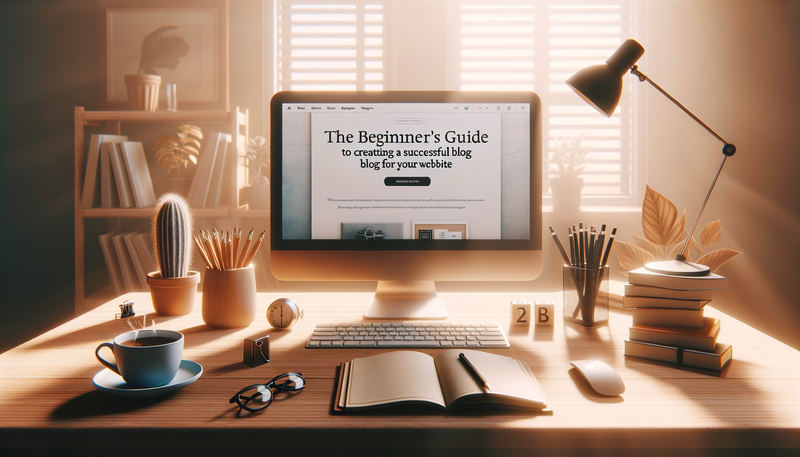The Beginner's Guide to Creating a Successful Blog for Your Website
Starting a successful blog for your website can be a powerful way to engage your audience, boost your online presence, and establish your authority in your niche. This comprehensive guide will walk you through the essential steps of creating and maintaining a thriving blog, from selecting the right topics to crafting compelling content and promoting your posts effectively. Whether you're a beginner or looking to improve your existing blog, this article will provide you with valuable insights and practical tips to help you achieve your blogging goals and drive traffic to your website.Table of Contents:
-
Choose Your Niche and Define Your Target Audience
- Develop a Content Strategy and Editorial Calendar
- Craft Compelling Headlines and Introductions
- Write High-Quality, Valuable Content
- Optimize Your Content for Search Engines
- Enhance Your Posts with Visuals
- Promote Your Blog Posts Effectively
- Engage with Your Readers and Build Community
- Analyze and Refine Your Strategy
- Develop a Content Strategy and Editorial Calendar
- Craft Compelling Headlines and Introductions
- Write High-Quality, Valuable Content
- Optimize Your Content for Search Engines
- Enhance Your Posts with Visuals
- Promote Your Blog Posts Effectively
- Engage with Your Readers and Build Community
- Analyze and Refine Your Strategy

Choose Your Niche and Define Your Target Audience
The first step in creating a successful blog is to identify your niche and target audience. Consider your expertise, passions, and the needs of your potential readers. Research popular topics within your industry and look for gaps in existing content that you can fill.Once you've chosen your niche, create detailed buyer personas to understand your audience's demographics, interests, and pain points. This information will guide your content creation and help you tailor your writing style to resonate with your readers. Remember, a well-defined niche and target audience will make it easier to create relevant, valuable content that attracts and retains loyal followers.
Do you need a website? Want to build a website but don't know where to start? Our website builder is the perfect solution. Easy to use, and with the ability to customize to fit your business needs, you can have a professional website in no time.
Develop a Content Strategy and Editorial Calendar
A solid content strategy is crucial for maintaining a consistent and engaging blog. Start by brainstorming a list of potential topics that align with your niche and audience interests. Group these topics into categories to ensure you're covering a diverse range of subjects within your field.Create an editorial calendar to plan and schedule your content in advance. This will help you maintain a regular posting schedule and ensure you're covering all relevant topics. Consider incorporating different content types, such as how-to guides, listicles, case studies, and industry news updates, to keep your blog fresh and interesting. Don't forget to leave room for timely, trending topics that may arise in your industry.
Craft Compelling Headlines and Introductions
Your blog post's headline and introduction are crucial for capturing readers' attention and encouraging them to continue reading. Spend time crafting catchy, descriptive headlines that clearly communicate the value of your content. Use power words, numbers, and questions to make your headlines more engaging.For your introductions, hook readers with a provocative statement, a relevant statistic, or a relatable anecdote. Clearly state the problem your post will address and the benefits readers will gain from your content. Keep your introductions concise and compelling, enticing readers to dive into the main body of your post.
Building a website with SITE123 is easy
Write High-Quality, Valuable Content
The heart of a successful blog lies in its content. Focus on creating in-depth, well-researched articles that provide genuine value to your readers. Use a conversational tone and break up your content into easily digestible sections with subheadings.Incorporate relevant examples, case studies, and data to support your points and add credibility to your content. Use bullet points and numbered lists to highlight key information and make your posts more scannable. Don't forget to include a strong call-to-action (CTA) at the end of each post, encouraging readers to engage further with your content or take a desired action.
Optimize Your Content for Search Engines
Search engine optimization (SEO) is essential for increasing your blog's visibility and attracting organic traffic. Conduct keyword research to identify relevant terms and phrases your target audience is searching for. Incorporate these keywords naturally throughout your content, including in your headlines, subheadings, and meta descriptions.Optimize your blog posts' URLs, title tags, and image alt text for better search engine visibility. Create internal links between related posts to improve navigation and keep readers engaged on your site. Additionally, focus on creating long-form, comprehensive content that thoroughly covers your chosen topics, as search engines tend to favor in-depth articles.
Enhance Your Posts with Visuals
Incorporating visuals into your blog posts can significantly improve engagement and make your content more shareable. Use high-quality images, infographics, and videos to illustrate your points and break up large blocks of text. Create custom graphics or charts to present data in a visually appealing way.Ensure all visuals are properly optimized for web use to maintain fast loading times. Add descriptive alt text to images for better accessibility and SEO. Consider creating branded templates for your blog images to maintain a consistent visual style across your posts.
Promote Your Blog Posts Effectively
Creating great content is only half the battle; you also need to promote it effectively to reach your target audience. Share your blog posts on social media platforms where your audience is most active. Tailor your messaging for each platform to maximize engagement.Consider reaching out to influencers or industry experts to share your content or collaborate on posts. Engage with other bloggers in your niche by commenting on their posts and sharing their content. This can help build relationships and increase your blog's visibility within your industry. Additionally, consider repurposing your blog content into other formats, such as podcasts or videos, to reach a wider audience.
Engage with Your Readers and Build Community
Fostering a sense of community around your blog can help build a loyal readership and increase engagement. Encourage comments on your posts and respond promptly to reader questions and feedback. Consider adding a forum or discussion board to your website to facilitate conversations among your readers.Host live Q&A sessions or webinars to interact with your audience in real-time. Create a newsletter to keep your readers informed about new content and exclusive offers. By actively engaging with your audience, you'll build stronger relationships and gain valuable insights into their needs and preferences.
Analyze and Refine Your Strategy
Regularly analyze your blog's performance using tools like Google Analytics to identify which posts are resonating with your audience and which topics need improvement. Pay attention to metrics such as page views, time on page, and bounce rate to gauge the effectiveness of your content.Use this data to refine your content strategy and focus on creating more of what works best for your audience. Experiment with different content formats, posting schedules, and promotion techniques to optimize your blog's performance. Don't be afraid to update or repurpose older posts that continue to attract traffic, keeping them relevant and valuable for your readers.





